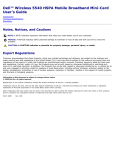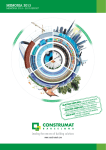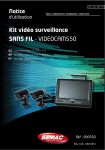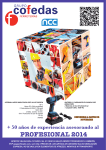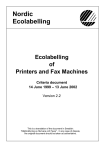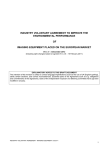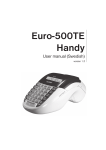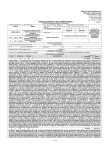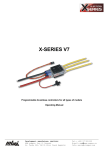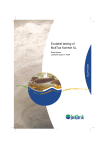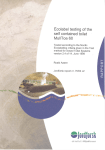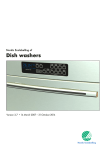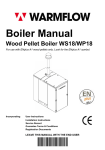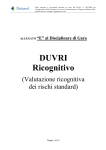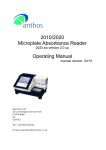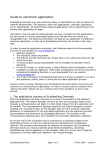Download Kontorsmaskiner
Transcript
Remissammanställning för Kontorsmaskiner version 6 2 Maj 2013 Nordisk Miljömärkning Svanenmärkta Kontorsmaskiner - Remissammanställning 071/Version 5, 2 Maj 2013 1 2 3 4 Sammanfattning .............................................................. 1 Om remissen ................................................................... 1 Sammanställning av inkomna svar .................................. 2 Kommentarer till kriterierna, i detalj ............................... 3 4.1 4.2 4.2.1 4.2.2 4.3 5 6 Generella kommentarer ................................................................. 3 Produktgruppsavgränsning ............................................................ 5 Vad kan Svanenmärkas? .............................................................................................. 5 Vad krävs för att bli Svanenmärkt? ............................................................................ 5 Kommentarer till de individuella kraven ........................................ 5 4.3.1 Krav kapitel 2 ................................................................................................................ 5 4.3.2 Bilagorna ........................................................................................................................ 14 Kommenterar till bakgrunden, i detalj ............................. 15 Diskussion och slutsatser ................................................ 17 ii Nordisk Miljömärkning Remissammanställning Kontorsmaskiner 015/version 6.0 2 Maj 2013 1 Sammanfattning Total inkom 11 remissvar till förslaget på nya kriterier för miljömärkning av kontorsmaskiner. 2 remissinstanser stödjer förslaget och övriga hade bra kommentarer som i vissa fall har lett till att kraven justerats. Det kommenterades att det är bra om de miljömärkningar som finns för produktgruppen är harmoniserade. Nordisk Miljömärkning strävar efter en harmonisering av kriterierna. Vi har i dessa kriterier en lista med kraven som behöver uppfyllas om man redan har en annan miljömärkning (Blå Ängel). Kravet på återvunnen plast kommenterades i remissen. Det var frågor om definitioner om vad återvunnen plast är. Remissinstanserna som kommenterade kravet var dock positivt inställd till att man ställer krav på återvunnen plast i miljömärkningskriterier. Kraven på flamskyddsmedel och mjukgörare som tillsätts plats till produkten kommenterades. Efter remissen har man arbetat om kraven för flamskyddsmedel och ftalater som tillsätts plast eller gummi i produkten. För denna produktgrupp är kravet på ftalater begränsat till den externa kraftkabeln. Vi har tidigare inte haft krav på ftalater och vi börjar nu med att ställa krav på den delen av produkten. Kraven på flamskyddsmedel har harmoniserat för elektroniska produkter som Nordisk Miljömärkning har kriterier för. Vi har valt att utesluta flamskyddsmedel med kända farliga egenskaper och i tillägg utesluta flamskyddsmedel med klassificerade med riskfraser för s.k. CMR-ämnen, Cancerframkallande, mutagena och reproduktionsstörande ämnen kallas tillsammans för CMR-ämnen. Kraven på andel återvunnet material i förpackningar kommenterades. Nordisk Miljömärkning har justerat ned kravnivån efter remissen. 2 Om remissen Denna remiss gäller för kriterierna för Kontorsmaskiner. Remissen genomfördes hösten 2012. Målsättningen med denna revision var att kriterierna ska revideras med följande fokuspunkter: Kravnivån för produktens energiförbrukning, materialkrav, utsläpp och ljudnivå bör ses över och anpassas/harmoniseras till de andra miljömärkningarna EU Ecolabel, Ecomark och Blå Ängeln. Kravet på flamskyddsmedel bör ses över och justeras så att det även omfattar miljökrav Se om det är möjligt att ställa krav på för återvunnen eller återanvänd eller biobaserad plast. Kraven för tillsatser i plast ska eftersträva att minimera mängden tillsatser och förtydliga de tillsatta ämnenas effekter på hälsa och miljö. 1 Nordisk Miljömärkning Remissammanställning Kontorsmaskiner 015/version 6.0 2 Maj 2013 Förpackningskraven ska uppdateras. En eventuell harmonisering med TCO och EPEAT som ställer krav på förpackningen. Elsäkerhetskrav ska förslås. Bör ingå för att säkerställa produktsäkerhet och minska risken för brand på grund av eventuellt bristfällig isolation. TCO ställer krav på elsäkerhet. Etiska krav beskrivna i kriterierna för datorer och ljud & bild ses över om de kan läggas till kontorsmaskiner också. I denna sammanställning är alla kommentarer insamlade och besvarade av Nordisk Miljömärkning. Syftet är, förutom att samla in alla kommentarer, att visa hur externa synpunkter har påverkat kraven. Nordisk Miljömärkning är tacksam för alla svar som hjälper oss i vår utveckling och hjälper oss att se till att arbetet på kriterierna följer standarden ISO 14024. 3 Sammanställning av inkomna svar Totalt svarade 11, av dessa godkände 2 förslaget, 0 motsatte sig förslaget och 9 tog inte ställning. Tabell 1: Sammanställning av svaren. Kolumnerna visar: A. Bara kommentarer, B. Stöder förslaget, C. Stöder förslaget med kommentarer, D. Avstår från yttrande och E. Förkastar förslaget med motivering. Land Danmark Sverige Finland Norge Island Totalt A. Bara kommen tarer. 0 6 0 0 0 6 B. Stöder förslaget. 0 1 0 0 0 1 C. Stöder förslaget med kommentarer. 0 1 0 0 0 1 D. Avstår från yttrande. 0 0 2 1 0 3 E. Förkastar förslaget med motivering. 0 0 0 0 0 0 Totalt 0 8 2 1 0 11 Tabell 3: Svenska remissvar. Remiss-instans Brother Canon Energimyndigheten HP Jordens Vänner Kyocera Japan Kyocera UK EFRA Σ Svenska svar: A. Bara kommentarer. B. Stöder förslaget. C. Stöder förslaget med kommentarer. D. Avstår från yttrande. E. Förkastar förslaget med motivering. X X X X X X X X 6 1 1 0 0 2 Nordisk Miljömärkning Remissammanställning Kontorsmaskiner 015/version 6.0 2 Maj 2013 Tabell 4: Finska remissvar. Remiss-instans A. Bara kommen tarer. Kuluttajatutkimuskeskus [inga kommentarer] Sisäministeriö [inga kommentarer] Σ Finska svar: B. Stöder förslaget. C. Stöder förslaget med kommentarer. D. Avstår från yttrande. E. Förkastar förslaget med motivering. X 0 0 X 2 0 0 Tabell 5: Norska remissvar. Remiss-instans Arbeidstillsynet [inga kommentarer] Σ Norska svar: A. Bara kommen tarer. 0 B. Stöder förslaget. C. Stöder förslaget med kommentarer. 0 0 D. Avstår från yttrande. X E. Förkastar förslaget med motivering. 1 4 Kommentarer till kriterierna, i detalj 4.1 Generella kommentarer Canon 0 I förslaget vill ni inte längre att kraven på produkten ska vara helt harmoniserade med Blue Angel och japanska Ecomark. Detta tycker vi är mycket olyckligt. Vi anser att detta inte kommer att gynna Svanen. Tvärtom. Vi anser därför att ni bör återgå till att helt harmoniserande med dessa miljömärken. Detta gynnar alla, både företag men även slut kunder. Förhållningssättet med harmonisering har varit framgångsrikt, är dessutom är långsiktigt och ger ökad förståelse och kunskap både hos företag och kunder. Canon föreslår därför att ni tar bort alla extrakrav, R1. Vi föreslår också att ni tydligt markerar vilka av de övriga kriterierna som följer kraven enligt LOU. Detta för att underlätta användingen av era krav i offentligt upphandling, som i dag är omöjligt. Ert förslag, med icke harmonisering innebär bland annat: - att detta bäddar för missförstånd i upphandlingar både privata, men i vissa fall även offentliga. Vanligt förekommande uttryck i upphandlingsunderlag är ”Svanen eller motsvarande”, något ”motsvarande” kommer inte längre att finnas. Detta kommer att orsaka stora besvär och förvirring för inköpare och upphandlare, helt i onödan. - då ni inför extrakrav innebär detta extra arbete och administration för företag som redan har Blue Angel men som även vill skaffa Svanen. Ni underlättar inte. Detta kommer att innebära att intresset för Svanen kommer att minska. Företag måste prioritera sina resurser. Detta beslut gör att ni tar ett stort steg tillbaka, mot de förra kriterierna, där full harmonisering av produktkraven fanns. Harmonisering underlättade för företagen. 3 Nordisk Miljömärkning Remissammanställning Kontorsmaskiner 015/version 6.0 2 Maj 2013 Nordisk Miljömärknings kommentar Nordisk Miljömärkning är enig om att harmonisering med andra aktiva miljömärkningar är viktigt. Vi strävar efter att kriterierna ska vara harmoniserade med andra miljömärkningsordningar. Samtidigt måste Nordisk Miljömärkning regelbundet revidera kriterierna så de miljömässigt bättre produkterna miljömärks. K1/R1 i förslagna kriterier är ett resultat av en delvis harmonisering med Blå Engeln, delvis harmonisering med EU Ecolabel och liten eller ingen harmonisering med EcoMark. Detta pga. av att den japanska miljömärkningsorganisationen inte hade påbörjat en revidering av motsvarande produktgrupp samtidigt som Blå Engeln och EU Ecolabel befann sig i en revideringsprocess för kontorsmaskiner. Givetvis har vi fortsatt kontakt med andra miljömärken och strävar efter att ha harmoniserade krav i kommande kriterieutvecklingar. Slutligen vill Nordisk Miljömärkning i större utsträckning arbeta med att anpassa sina krav för offentlig upphandling. HP EU GPP - eco labels – eco label criteria Most public procurers are aware that asking for eco label certified products is not allowed in public procurement. At the same time, many seem to believe that all of the imbedded eco label criteria are suitable candidates for public procurements. This is not correct as each single criterion must meet the legal provisions of article 23 of 2004/18/EC and some other basic principles. In short, GPP criteria must be based on scientific information, be possible to quantify, verify and control. Also, the environmental attribute must be linked to the subject matter of the contract. To increase the quality of all future Nordic Swan criteria, we recommend that criteria like energy efficiency and noise, suitable in GPP, be highlighted in your final criteria document. Nordisk Miljömärknings kommentar Nordic Ecolabelling wishes to adapt its requirements for public procurement in a larger extent ahead. Nordic Ecolabelling will develop guides for how to use the Ecolabel criteria for GPP. For criteria that are frequent used in GPP there will be specific guides. Kyocera Japan R1 says if the product has a valid Blue Angel License, such product just needs to comply with R4, R10, R13, R15, R16, R19 Chapter 5 and Appendix 2. R9 Flame retardants are not included here. This means that we do not need to submit the evidence of compliance with R9, but Blue angel requirement of flame retardants differ from NS Ver6.0. So we would like to harmonize this requirement with RAL-UZ171 3.1.2.1 Nordisk Miljömärknings kommentar Nordic Ecolabelling will add R9 to R1. Kyocera UK Design for disassembly does not appear to feature either in the proposed criteria or the roadmap for future criteria. By this, we mean the products should be able to be disassembled using a minimal number of different tools, that parts should where possible clip together rather than relying on metal fixings and that plastic parts of sufficient size should be embossed with material codes so that it is clear what process should be used to recycle them. 4 Nordisk Miljömärkning Remissammanställning Kontorsmaskiner 015/version 6.0 2 Maj 2013 Nordisk Miljömärknings kommentar Nordic Ecolabelling will add a requirement for disassembly. This requirement is harmonized with EU Ecolabel criteria. 4.2 4.2.1 Produktgruppsavgränsning Vad kan Svanemärkas? Inga kommentarer 4.2.2 Vad krävs för att bli svanenmärkt? Inga kommentarer 4.3 4.3.1 Kommentarer till de individuella kraven Krav kapitel 2 R1 Valid Blue Angel license Inga kommentarer R2 Description of the product Inga kommentarer R3 Energy consumption Energimyndigheten Kyocera UK Regarding energy consumption (R3), harmonisation with the latest version of Energy Star seems logical, as does the documentation. Nordisk Miljömärknings kommentar Nordic Ecolabelling thanks you for your answer and strives to continue the harmonization ambition. R4 Re-used plastic Energimyndigheten 5 Nordisk Miljömärkning Remissammanställning Kontorsmaskiner 015/version 6.0 2 Maj 2013 Nordisk Miljömärknings kommentar Nordisk Miljömärkning tackar för remisskommentaren. Brother 1. We would like to know the difference between pre-consumer recycled plastic and post industrial recycled plastic. If both definition is same, it is OK. If both definition is different, we would like to admit pre-consumer recycled pastic, too. 2. Compared with large size copiers, there are many less 25g parts in printers. So we would like to admit total 25g with plural parts, too. Nordisk Miljömärknings kommentar Nordic Ecolabelling has specified the definition of recycled material in accordance with ISO 14021. PostConsumer Material are defined as Material generated by households or by commercial, industrial, and institutional facilities in their role as end-users of the product that can no longer be used for its intended purpose. This includes returns of materials from the distribution chain. Pre-Consumer Materials are defined as Material diverted from the waste stream during the manufacturing process. Excluded is the reutilization of materials such as rework, regrind or scrap generated in a process and capable of being reclaimed within the same process that generated it. Regarding the limit of 25 g please note that the percentage re-cycled and/or re-used plastic must not be 100% in that particular part. HP Please harmonize with EPEAT, IEEE1680.2 which has 5g. Not EU GPP acceptable requirement as it can’t be controlled. See European court of Justice, ECJ case Wien-strom C-448/01. Nordisk Miljömärknings kommentar Nordic Ecolabellings experience is that the 25g limit is feasible. Nordic Ecolabelling wishes to adapt its requirements for public procurement in a larger extent ahead. R5 Special requirements as to products with combined toner cartridges HP How come there are hardly any chemical substance requirements related to toner and ink whilst the NS criteria for remanufactured toner cartridges has many detailed substance requirements? We suggest that the chemical substance requirements in the Industry supplies IT co Declaration be considered to add. Nordisk Miljömärknings kommentar Nordic Ecolabelling has not had any intention to add requirements on substances related to toner and ink in the imaging equipment in this revision, mainly because Nordic Ecolabel has criteria sets for Toner cartridges. Nordic Ecolabelling will evaluate if it can be done in the coming revisions. R6 Single plastic casing parts Inga kommentarer R7 Combined plastic casing parts Inga kommentarer 6 Nordisk Miljömärkning Remissammanställning Kontorsmaskiner 015/version 6.0 2 Maj 2013 R8 Chlorine-based plastics HP Not EU GPP acceptable requirement, not based on scientific information. Nordisk Miljömärknings kommentar Nordic Ecolabelling has motivated the requirement in the background document. R9 Flame retardants EFRA Fire safety & flame retardants Flame retardants are used to make sure that a wide range of different products, such as imaging equipment, are fire safe. These products function on electrical current and produce heat. They often consist of a considerable amount of plastic, which, if not adequately protected, is easily ignitable and burns vigorously. Flame retardants are widely used to reduce the material flammability, allowing consumer or professional to use products which meet national and international fire safety standards and laws. Flame retardants save lives and properties by increasing the typical escape time and by facilitating evacuation and rescue operations in the event of a fire. General comment: there should be no flame retardant specific criteria “Flame retardants” describes a function and not a separate class or family of chemicals: there is no clear scientific or legal definition for this term and a wide range of different chemicals is used for that purpose. Certain flame retardant substances can also be used for other function beyond flame retardancy, for example as plastic softeners or fillers. Therefore, flame retardants should be treated as every other substance in any Nordic Swan product group and criteria. This is also acknowledged by the current EU Flower criteria for laptop and desktop computers which do not single out flame retardants but apply to all substances: 2011/330/EU and 2011/337/EU. EFRA therefore suggests removing the flame retardant specific criterion R9. Technical feasibility should be assured New risk phrases, connected to aquatic toxicity, have been added to the current criteria proposal. EFRA suggest to take these restrictions back again for the following reasons: both the Blue Angel and the EU Flower experienced difficulties in the past with too long lists of restricted risk phrase substances. Especially the long list of restricted substances in the EU Ecolabel Framework Regulation makes it almost impossible for industry to comply with the requirements. Exposure to substances should be taken into account There will only be a negligible risk to the environment once H400 and H410 (R50/53) or H411 (R51/53) substances are encapsulated in an E&E casing or reacted within a printed circuit board, as there will be no contact with water. The classification of chemicals is hazard-based, not risk-based. A hazard is not a true representation of a risk; a hazard only becomes a risk if one is actually exposed to this hazard. Computers are manufactured and used indoors (e.g. no contact to the aquatic environment) and subject to the WEEE/RoHS directives regarding end of life treatment. Once substances like flame retardants are safely incorporated in the polymer matrix of external casings or printed circuit boards of E&E medical devices, they do not pose a risk for the environment or human health. 7 Nordisk Miljömärkning Remissammanställning Kontorsmaskiner 015/version 6.0 2 Maj 2013 This argument is supported by the recently adopted EU Ecolabel criteria for laptops (2011/330/EU) and desktop computers (2011/337/EU) that state: “The use of substances or mixtures which change their properties upon processing (e.g. become no longer bioavailable, undergo chemical modification) so that the identified. hazard no longer applies is exempted from the above requirement.” EFRA calls for science-based approach Flame retardants consist of a large group of many different substances which can have very different environmental and health profiles. Consequently, the restriction of halogenated organic flame retardants is not justified. To the best of our knowledge, the chemical grouping of a flame retardant molecule per se can only inform about the way the compound will interact with the fire reaction. This is the reason why it is common industry practice to group flame retardants depending on the presence of certain elements in the molecules – including halogens. The sustainability of a substance should not be assessed on the basis of its elemental content as this fails to recognise that environmental and health profiles are specific to each individual substance. The presence (or absence) of a given chemical element in a flame retardant compound (e.g. Phosphorus, Aluminium, Magnesium, Chlorine, Bromine, Fluorine, Zinc, Nitrogen, Antimony, Boron, etc.) cannot be an indicator of their environmental and health profiles. EFRA therefore believes that halogenated flame retardants should be generally permitted by Nordic Swan criteria for imaging equipment. PBBs, PBDEs and chlorinated paraffins The old as well as the recast RoHS Directive (2011/65/EU) restricts two groups of flame retardants: Polybrominated biphenyls (PBB) and Polybrominated diphenyl ethers (PBDE). The manufacturing, marketing and use of PBBs stopped during the 1970’s and in the 1990’s. PBDE substances have been phased out by EFRA companies since 2004, with the exception of Deca-BDE. Deca-BDE belongs to the group of PBDEs and is thus also restricted by the RoHS Directive. Short-chain Chlorinated Paraffins (SCCP) and Medium-chain Chlorinated Paraffins (MCCP) are not produced by EFRA companies, so we are not able to comment on these substances. However, to our best knowledge they are typically not used as flame retardants in electric and electronic equipment including imaging equipment. We therefore believe it is redundant and confusing to explicitly name PBBs, PBDEs, Deca-BDE and chlorinated paraffins here and suggest deleting these references. Nordisk Miljömärknings kommentar For now we have focused on flame retardants in plastics as it is recognized/acknowledged environmental global problem. In future revision of the criteria we will try to include all additives in plastics. Nordic Ecolabelling has updated the requirements for flame retardants after the hearing. We still uses risk phrases for the requirement but has changed some risk phrases. The requirements for flame retardant exclude specific types of halogenated organic flame retardants and other must not be classified with certain risk phrases. There are exceptions made for printed circuit boards and smaller plastic parts. The requirements for aquatic toxicity are removed after the hearing. 8 Nordisk Miljömärkning Remissammanställning Kontorsmaskiner 015/version 6.0 2 Maj 2013 HP Here is our counter proposal Non halogenated flame retardants meeting any of the criteria a through e shown below shall not be used in plastic parts weighing more than 25 grams. a. PBT = High P + High B + [very High T (Ecotoxicity or Group II Human) or High T (Group I or II* Human)] b. vPvB = very High P + very High B c. vPT = very High P + [very High T (Ecotoxicity or Group II Human) or High T (group I or I* Human)] d. vBT = very High B + [very High T (Ecotoxicity or group II Human) or High T (group I or II* Human)] e. High T (group I Human). Compliance verification: alternative 1) signed letter by the flame retardant manufacturer, or (even stronger) 2) signed letter by an independent expert body, who under NDA with the substance manufacturer has checked the underlying test results ensuring the substance does not have any of the above listed properties. Why banning substances on their assigned risk phrases is not recommended This is not recommended, because: Risk phrases are self-declared and may vary from manufacturer to manufacturer. It is not uncommon for one manufacturer to list certain risk phrases for a sub-stance while another may list none. Also this information varies between databases for the same substance. Substances with limited data will have less self-declared risk phrases and may appear to be better alternatives but the real hazards may be unknown. There is little incentive for manufacturers to provide data that may result in assignment of a risk phrase. A chemical with limited data and unknown hazard could be selected because of the lack of risk phrases only to be considered a regrettable substitution later when additional hazard data is obtained. Compliance verification via self-declarations and/or safety data sheets is not enough as these documents only refer to currently available data but do not reveal the data gaps. According to the EU REACH regulation, stringent requirements apply for substances and mixtures of these. For substances in articles, like flame retardants in plastic parts, there is an obligation to inform about their presence in the finished product, if the substance is on the REACH candidate list. The substance hazard testing requirement are limited if imported in finished products. Nordisk Miljömärknings kommentar Nordic Ecolabelling thanks for the proposed criteria for flame retardants. Flame retardants other than defined specific halogenated organic must not be classified as H350, H350i, H340, H360F, H360D, H360Fd or H360Df. Nordic Ecolabelling has updated the requirements for flame retardants after the hearing. We still uses risk phrases for the requirement but has changed some risk phrases. Nordic Ecolabelling is aware of the problems with risk phrases and declarations from suppliers of chemical products. This is however the best system we have today and we will regularly do check-ups for classification for chemical substances. The requirements for flame retardant exclude specific types of halogenated organic flame retardants and other must not be classified with certain risk phrases. 9 Nordisk Miljömärkning Remissammanställning Kontorsmaskiner 015/version 6.0 2 Maj 2013 R10 Phthalates in external power cable Brother We would like to delete this requirement. Regarding the external power cable of imaging equipment, once the machine is set up, users does not touch the cable not so much. So the regulation for toys and childcare articles does not apply for the external cable of the imaging equipment. HP We can support the requirement as HP does have a power cord that meets this requirement. However, several of our customers who wanted this cord, have changed their mind when they realized it was 3 times more ex-pensive than the standard cord. Also an applicant for the Swan label, could avoid this requirement by simply not delivering a power cord together with the products. These substances are on the REACH candidate list. Nordisk Miljömärknings kommentar The requirements for phtalates have been updated after the hearing. Nordic Ecolabelling now excludes specific phthalates from the external power cable. Following phthalates are excluded from the external power cable: Di-2-ethylhexyl phthalate (DEHP) Dibutyl phthalate (DBP) Benzyl butyl phthalate (BBP) Dicyclohexyl phthalate (DCO) Diisobutyl phthalate (DIBP) Diisooctyl phthalate (DIOP) Diisononyl phthalate (DINP) Diisodecyl phthalate (DIDP) Diethyl butyl phthalate (DEBP) Dihexyl phthalate (DHP) Di-n-decyl phthalate (DNDP) Bis(2-methoxyetyl)ftalate Diisopentylftalate N-pentyl-isopentylftalate According to Danish law the phthalates DEHP, DBP, DIBP and BBP must not be used in products that are used and stored indoor, in basement or garage. Therefore this phthalates must not be used for products sold in Denmark. R11 Chemicals used during production HP Propose to delete. Since many years, this is a legal requirement not suitable in eco labels. To be met by all, does not differentiate. Nordisk Miljömärknings kommentar This is a convention-based requirement ratified by many countries globally and the use of such ozone depleting gases has decreased in such an extent that Nordic Ecolabelling assesses it mature enough to be deleted. 10 Nordisk Miljömärkning Remissammanställning Kontorsmaskiner 015/version 6.0 2 Maj 2013 R12 Plastic materials in packaging HP Plastic materials in primary packaging: Not appropriate in EU GPP, not based on scientific information. Nordisk Miljömärknings kommentar The main problem areas for PVC are waste processing, the use of additives and dioxin emissions, inter alia during the production of PVC. In the production of chlorine (chloralkali process) and in the production of PVC, small quantities of dioxins may be formed which are highly toxic. Nordic Ecolabelling will exclude PVC from packaging material. R13 Re-cycled material in packaging Brother The percentage of recycled material is not stable. According to IEEE1680.2-2012; 4.8.3.1 recovered content in select fiber-based packaging materials, minimum total recovered fiber content of corrugated fiberboard is 25%. We hope same percentage of recycled material. 80% is too high. HP OK, same as in EPEAT, IEEE1680.2 standard. EU GPP acceptable requirement, impossible to control. Nordisk Miljömärknings kommentar Nordic Ecolabelling is thankful for the comments. After the hearing the requirements will be adjusted to 50%. This is a more feasible level. R14 Supply of spare parts Inga kommentarer R15 Double-sided copying Brother The requirement of color printing devices and monochrome printing devices should be distinguished. As for color printing devices, the requirement is OK, but as for monochrome printing devices, appliances with a miximum operation speed of > 24 sheets per minutes for A4 size paper should be equiped with automatic double-side copying. If so, RAL-UZ171 and Energy Star ver.2.0 draft can be harmonized, too. Kyocera Japan I think R15 is same contents with RAL-UZ171, March 2013, But RAL-UZ171 has been changed because many users do not want to have doublesided copying as Stoddard. We would like to harmonize this requirement with RAL-UZ171 3.1.5. Nordisk Miljömärknings kommentar Nordic Ecolabelling assesses that the paper consumption of imaging equipment is such a heavy and significant environmental parameter that the threshold for which a duplex unit must be installed in equipment has been set to >19 IPM and therefore harmonized with the latest proposal for EU Ecolabel criteria for imaging equipment devices. 11 Nordisk Miljömärkning Remissammanställning Kontorsmaskiner 015/version 6.0 2 Maj 2013 R16 Consumables Energimyndigheten Kyocera Regarding proposed new requirements for consumables. We strongly welcome this addition, which directly addresses the waste associated with composite printer cartridges. The limit values are reasonable from Kyocera’s point of view. Nordisk Miljömärknings kommentar Nordic Ecolabelling thanks for the comments. R17 Emissions HP OK in eco label. Identical with RAL UZ 171, however, fine dust particles not included. Not EU GPP acceptable requirement, the maximum emission concentration levels are not based on scientific information. Nordisk Miljömärknings kommentar Nordic Ecolabelling wishes to adapt its requirements for public procurement in a larger extent ahead. Kyocera UK It should also be noted that the use of third-party compatible or refilled cartridges can cause VOC emissions that are outside manufacturer specifications due to different toner composition, and that if a machine has been certified to the Nordic Ecolabel criteria with manufacturer original consumables it cannot safely be assumed that the same machine would pass the test if different toner was used. Nordisk Miljömärknings kommentar Nordic Ecolabelling thanks you for your comments. This is an important parameter, however out of the control and scope of the Nordic Ecolabel. The emission requirement is posed on the original cartridge for the imaging device, tested in a chamber. However, Nordic Ecolabelling recommends manufacturers to inform consumer through the user manual that emission conditions might changes with non-original toner cartridges. R18 Sound effect HP Please change to: Sound power Nordisk Miljömärknings kommentar Nordic Ecolabelling will change to the more appropriate “Sound Power”. R19 Working Conditions Brother The requirement of environmental label should focus on environment-friendly design. 'Code of conduct' belongs to law about work safety, it is not appropriate for the 12 Nordisk Miljömärkning Remissammanställning Kontorsmaskiner 015/version 6.0 2 Maj 2013 requirement of environmental label. Regarding heavy-metal containing material in product, there is RoHS regulation. As long as the certified product compy with RoHS regulation, there is no heavy-metal contaminated working condition. Nordisk Miljömärknings kommentar Nordic Ecolabelling believes that ecolabelled products should not only be the best choice in terms of the environment, but also in terms of working conditions. For this reason, in the version 6.0 of the criteria, Nordic Ecolabelling has introduced a new requirement for Code of Conduct which does not only address heavy-metal working conditions. HP EU GPP acceptable requirement, however only as contract performance clause. Nordisk Miljömärknings kommentar Nordic Ecolabelling thanks for the comments. R20 Information to consumers HP Please clarify and adjust. Must accept info on the web. Nordisk Miljömärknings kommentar Nordic Ecolabelling thanks for the comment and will clarify that info on the web is accepted. R21 Re-cycling and re-use of consumer durables and parts that wear out Inga kommentarer R22 Service and support Nordisk Miljömärknings kommentar Nordisk Miljömärkning tackar för kommentaren. Vi tar bort ”officiellt”. Det som avses är svenska, danska eller norska, finska eller isländska. R23 The quality of the product Inga kommentarer R24 Nordic Ecolabel licence contact Inga kommentarer R25 Documentation Inga kommentarer R26 Planned changes Inga kommentarer R27 Unplanned nonconformities Inga kommentarer 13 Nordisk Miljömärkning Remissammanställning Kontorsmaskiner 015/version 6.0 2 Maj 2013 R28 Traceability Inga kommentarer R29 Take-back system HP Suggest to delete. Legal requirement, remove. Not EU GPP acceptable requirement. To be met by all, does not differentiate the bidders. Nordisk Miljömärknings kommentar För produkten gäller WEEE, men för förpackningar är det inte alltid lagkrav på att vara ansluten till insamlingssystem i alla nordiska länder. Nordisk Miljömärkning upplever att det inte alltid uppfylls vid licensiering och kravet fyller en funktion. Därför har vi kravet. R30 Legislation and regulations Inga kommentarer R31 Marketing Inga kommentarer 4.3.2 Bilagorna EFRA Appendix 7 – Flame Retardant manufacturer’s declaration Flame Retardant manufacturers, as well as other suppliers of chemical substances, compile Material Safety Data Sheets (MSDS) to their best knowledge, including the assignment of risk phrases. Explaining on a few lines in an appendix as “background information” why the excluded risk phrases have not been assigned to a given flame retardant is neither practical nor necessary. Furthermore, due to the complexity of the supply chains, OEMs who finally have to apply for the Nordic Swan, might not always know the flame retardant manufacturer. Implementation and compliance verification of the requirements under Appendix 7 might therefore be very challenging. In order to keep the criteria feasible, EFRA suggests to at least deleting the requirement for flame retardant manufacturers why certain risk phrases have not been assigned to a given flame retardant substance. HP Why banning substances on their assigned risk phrases is not recommended This is not recommended, because: Risk phrases are self-declared and may vary from manufacturer to manufacturer. It is not uncommon for one manufacturer to list certain risk phrases for a sub-stance while another may list none. Also this information varies between databases for the same substance. Substances with limited data will have less self-declared risk phrases and may appear to be better alternatives but the real hazards may be unknown. There is little incentive for manufacturers to provide data that may result in assignment of a risk phrase. A chemical with limited data and unknown hazard could be selected because of the lack of risk phrases only to be considered a regrettable substitution later when additional 14 Nordisk Miljömärkning Remissammanställning Kontorsmaskiner 015/version 6.0 2 Maj 2013 hazard data is obtained. Compliance verification via self-declarations and/or safety data sheets is not enough as these documents only refer to currently available data but do not reveal the data gaps. According to the EU REACH regulation, stringent requirements apply for substances and mixtures of these. For substances in articles, like flame retardants in plastic parts, there is an obligation to inform about their presence in the finished product, if the substance is on the REACH candidate list. The substance hazard testing requirement are limited if imported in finished products. Nordisk Miljömärknings kommentar Nordic Ecolabelling excludes specific halogenated organic flame retardants with documented environmental risks. The background for the criteria has been updated and clarified after the hearing. In addition to this we also exclude flame retardants with classification. We have exemptions from the exclusion for small plastic parts and printed circuit boards to make the criteria feasible. Nordic Ecolabelling will adjust the appendix but will keep the requirement that the flame retardant producer shall declare that the flame retardant fulfills the requirement. Nordic Ecolabelling is aware of the problems with risk phrases and declarations from suppliers. This is however the best system we have today and we will regularly do check-ups for classification for chemical substances. The requirements for flame retardant exclude specific types of halogenated organic flame retardants and other must not be classified with certain risk phrases. 5 Kommenterar till bakgrunden, i detalj EFRA Background document (p. 5; 14) This text implies that all flame retardants are hazardous. However, as highlighted here above, flame retardants are a group of many different substances with different properties. Labelling all brominated flame retardants as a “hazardous” is neither correct nor scientifically justified. Many flame retardants are neither classified nor Labeled Background document: Chemicals (p. 6) TBBPA is a very well-known substance that has been risk assessed by the EU and the WHO with the result that TBBPA does not pose a risk to human health. It was REACHregistered in 2010 and is also RoHS compliant. There is no scientific justification to exclude TBBPA from Nordic Swan ecolabelled imaging equipment. Background document: Flame Retardants (p. 6) The current RoHS Directive (2011/65/EU) restricts all PBBs and PBDEs including Deca-BDE for all E&E equipment including imaging equipment. In order to avoid confusion, the Background document should not single out substances that are legally restricted anyway. As correctly stated in the Background document, the separate sorting of BFR-containing plastics is mandatory for EEE covered by the WEEE directive (though not always necessary as long as no additional hazardous waste stream is produced), but this is seen as positive in view of end-of-life treatment. This requirement is essentially applicable to relatively large parts of plastics, such as casings. 15 Nordisk Miljömärkning Remissammanställning Kontorsmaskiner 015/version 6.0 2 Maj 2013 Plastics in general and plastics containing phosphorus flame retardants are different from plastics containing brominated flame retardants (BFRs) and not always compatible. Clean mono plastic streams are needed to perform high-quality mechanical recycling. As such, separate treatment that allows the gathering of a feedstock with limited and identifiable plastic types with high purity is seen as an asset. In the professional printing/copier “Large amounts of waste are generated containing hazardous substances such as flame-retardants and heavy metals.” (p. 5; 14) world, this requirement combined with excellent recycling capabilities of certain BFR formulation allows closedloop approaches to material efficiency, which keeps the environmental footprint very low. The link between the halogen content of incinerated materials and the formation of dioxins and furans has often been discussed. The European Commission, in its Green Paper on the Environmental Issues of PVC, indicates that “it is most likely that the main incineration parameters, such as the temperature and the oxygen concentration, have a major influence on the dioxin formation”.1 Dioxin formation can also occur naturally, for example through forest fires2, and depends mostly on the oxygen content and the temperature of the incineration process. During the incineration process, PBDD/F formation is not altered by the presence of the bromine-containing waste and remains well within emission standards. The Organization for Economic Cooperation and Development3 (OECD) also attests to the minimal risks during such incineration9; they conclude there is insignificant formation of dioxins/furans when incinerating brominated flame retardants. The OECD noted that, during laboratory experiments, the highest formation rates for brominated dioxins/furans from PBDEs were associated with low temperatures and pyrolitic conditions. Modern waste-to-energy facilities are specifically designed to avoid these conditions. Furthermore, the amount of formed brominated dioxins and furans is relatively small compared to other compounds such as hydrogen cyanide (HCN) and polyaromatic hydrocarbons (PAHs), which are among the most toxic substances released in any fire. Brominated dioxins can also decompose faster to other non-toxic compounds such as sodium-bromide (mineralisation) due to the fact that a bromine molecule is much bigger than a chlorine molecule. Besides that, there are emission limit values for dioxin/furan emissions in the EU for waste incinerators and operators have to comply with these requirements (formerly Waste Incineration directive (2000/76/EC), now integrated into the Industrial Emissions Directive (2010/75/EC). Background document: p. 17 The distinction between additive and reactive flame retardants does not provide any information about the environmental and health profiles of a certain flame retardant substance or the possibility of leaching. EFRA suggests correcting these sections of the background document accordingly, taking into account the information given here above. 16 Nordisk Miljömärkning Remissammanställning Kontorsmaskiner 015/version 6.0 2 Maj 2013 Nordisk Miljömärknings kommentar The background for the criteria has been updated and clarified after the hearing. The Nordic Ecolabel excludes specific halogenated organic flame retardants with documented environmental risks. We have exemptions from the exclusion for small plastic parts and printed circuit boards to make the criteria feasible. 6 Diskussion och slutsatser Remisskommentarerna täckte flera av de föreslagna kraven i den nya versionen av kriterierna. Det kommenterades att det är bra om de miljömärkningar som finns för produktgruppen är harmoniserade. Nordisk Miljömärkning strävar efter en harmonisering av kriterierna. Vi har i dessa kriterier en lista med kraven som inte behöver uppfyllas om man redan har en annan miljömärkning (Blå Ängel). Kravet på återvunnen plast kommenterades i remissen. Det var frågor om definitioner om vad återvunnen plast är. Remissinstanserna som kommenterade kravet var dock positivt inställd till att man ställer krav på återvunnen plast i miljömärkningskriterier. Det är möjligt att detta är ett område man kan utveckla kriterierna på i en kommande revision. Kraven på flamskyddsmedel och ftalater som tillsätts plats till produkten kommenterades. Efter remissen har man arbetat om kraven för flamskyddsmedel och ftalater som tillsätts plast eller gummi i produkten. För denna produktgrupp är kravet på ftalater begränsat till den externa kraftkabeln. Vi har tidigare inte haft krav på ftalater och vi börjar nu med att ställa krav på den delen av produkten. Kraven på flamskyddsmedel har harmoniserat för elektroniska produkter som Nordisk Miljömärkning har kriterier för. Vi har valt att utesluta flamskyddsmedel med kända farliga egenskaper och i tillägg utesluta flamskyddsmedel med klassificerade med riskfraser för s.k. CMR-ämnen, Cancerframkallande, mutagena och reproduktionsstörande ämnen kallas tillsammans för CMR-ämnen. Kraven på andel återvunnet material i förpackningar kommenterades. Nordisk Miljömärkning har justerat ned kravnivån efter remissen. 17




















